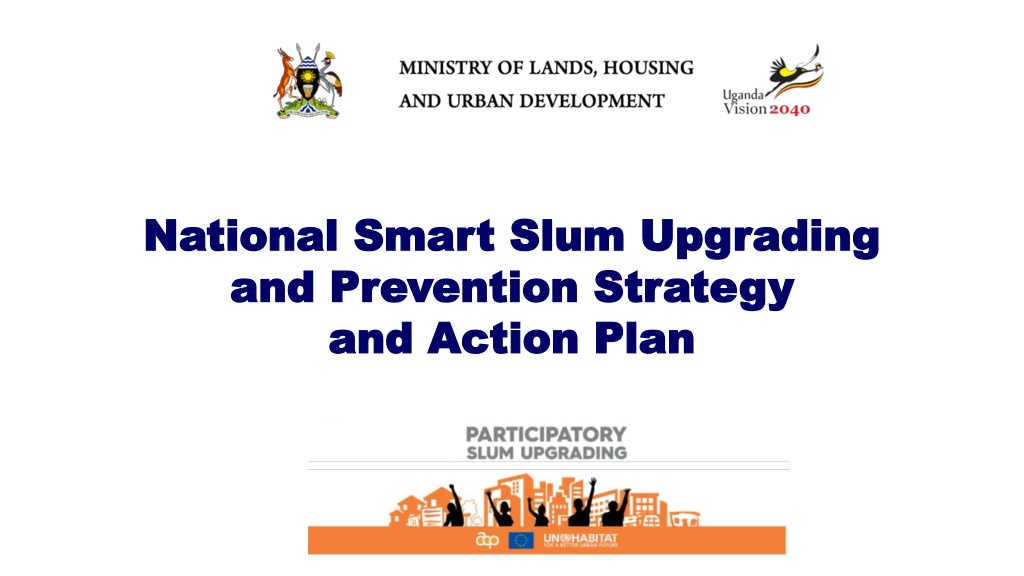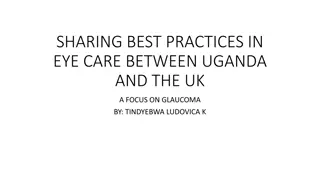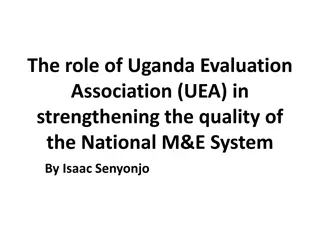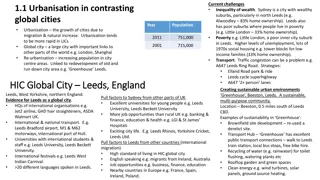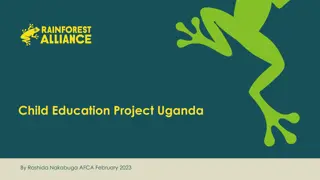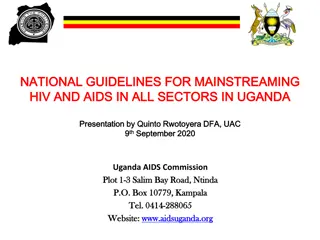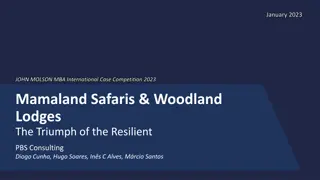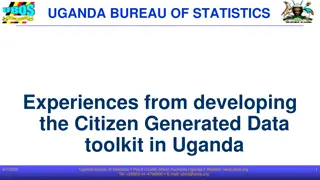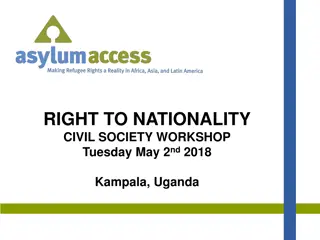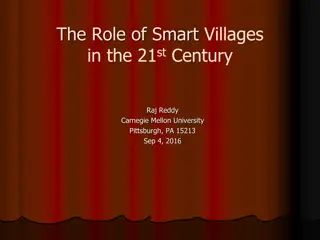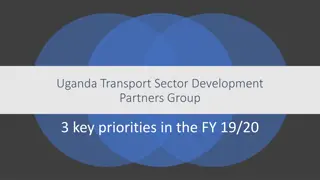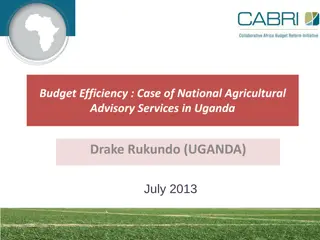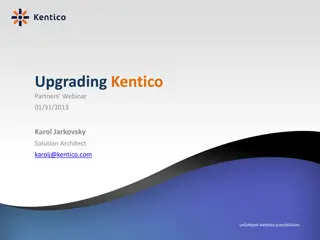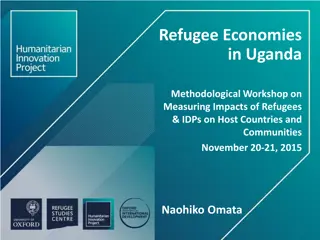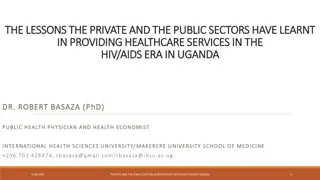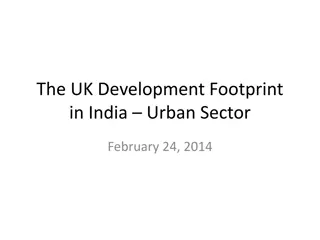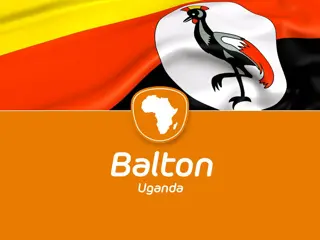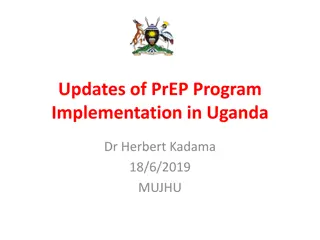National Smart Slum Upgrading and Prevention Strategy in Uganda
The National Smart Slum Upgrading and Prevention Strategy in Uganda addresses the challenges faced by slum residents, focusing on improving living conditions, preventing future slum growth, and integrating participatory measures for sustainable development. The strategy outlines the context of slum conditions, contributory factors, and the objectives of slum upgrading initiatives in Uganda.
Download Presentation

Please find below an Image/Link to download the presentation.
The content on the website is provided AS IS for your information and personal use only. It may not be sold, licensed, or shared on other websites without obtaining consent from the author. Download presentation by click this link. If you encounter any issues during the download, it is possible that the publisher has removed the file from their server.
E N D
Presentation Transcript
National Smart Slum Upgrading National Smart Slum Upgrading and Prevention Strategy and Prevention Strategy and Action Plan and Action Plan
Presentation Outline Presentation Outline The Slum Challenge in Uganda National Slum Upgrading Strategy and Action Plan 2008 Participatory Slum Upgrading Programme (PSUP) Rationale for the Revised Strategy and Action Plan Integrated PESTLE framework and SWOT analysis Smart City Concept Concept, Definition and Operationalization of Smart Slum Upgrading Smart Slum Upgrading and Prevention Strategy Framework Principles Enablers Actions Smart Slum Upgrading and Prevention Strategy Results Framework Outcomes Smart Upgraded Slums Descriptors
The Slum Challenge in Uganda Total population 43.6 M Slum defined as an area with the following characteristics: UN-Habitat : Inadequate access to safe water, Inadequate access to sanitation Insecure residential status Poor structural quality of housing Overcrowding Urban population share 11.4% Urban population growth rate 5.2% Uganda specific: o Attracts a high density of low income earners and/or unemployed persons, with low literacy levels o High rates/levels of noise, crime, drug abuse, immorality (pornography and prostitution) and alcoholism and high HIV/AIDS prevalence. o Houses are in environmentally fragile lands, Urban population living in poverty 19.8% Urban population living in slums 60%
Housing and living conditions in slums in Kampala City
Contributory factors to continued development and expansion of slums High urbanization rate Urban poverty Lack of urban planning and development control Complex urban land tenure systems The effect of decentralization and poor urban governance Poor management of privatized urban services Extension of boundaries of urban centres
National Slum Upgrading Strategy and Action Plan 2008 Goal: To improve the living conditions of slum residents living in the most depressed physical conditions in Uganda s urban areas on a sustainable basis and to prevent future slum growth. Objectives of Slum Upgrading 1) To develop affordable and participatory measures for upgrading housing conditions and related support infrastructure in slum areas. 2) To plan and implement in collaboration with stakeholders programmes and pilot projects to minimize, eliminate and curtail the growth of slums. 3) To harness central government s and urban authority(ies) s resources in enhancing the contribution of slums to the urban economy. 4) To ensure an appropriate institutional framework and mechanisms for effective implementation of slum upgrading programmes by different stakeholders.
Participatory Slum Upgrading Programme (PSUP) Launched in 2008 as a tripartite initiative of the Secretariat of the Africa, Caribbean and Pacific Group of States (ACP), the European Commission (EU) and UN-Habitat. Mission: to improve the living conditions of the urban poor by encouraging and promoting a collaborative process which involves all stakeholders, thereby motivating countries to further dedicate efforts and resources to upgrade slums and prevent the formation of new ones. Key aim: to promote the creation of an enabling environment for slum upgrading and to institutionalize a more positive outlook on slum dwellers. Tailored to specifically deliver on SDG 11.1: By 2030, ensure access for all to adequate, safe and affordable housing and as well as SDG 1, SDG 5, SDG 6, SDG 7, SDG 10, SDG 16, and SDG 17. basic services and upgrade slums ,
Rationale for the Revised Strategy and Action Plan Rationale for the Revised Strategy and Action Plan Changes in the national urban demographic, spatial and policy environment in particular the National Housing Policy; National Urban Policy; Third National Development Plan (NDPIII) Key new global development frameworks: Sustainable Development Goals (SDGs) and SDG Target 11.1 on access to adequate, safe and affordable housing and basic services, and upgrading slums; adoption of the New Urban Agenda (NUA); introduction of smart city concepts. The review of the current National Slum Upgrading Strategy and Action Plan identified policy, institutional, structural and financing gaps that need to be addressed in the formulation and implementation of a national slum upgrading programme. The review identified opportunities that can facilitate the above, and policy and strategic entry points for such a programme. These include the National Housing Policy; National Urban Policy; NDPIII Sustainable Urbanization and Housing Programme Implementation Action Plan (PIAP) ; and lands, housing and urban development sector strategies and development plans. The revised strategy and action plan will guide the formulation of a national slum upgrading programme with high human development impact in slums and informal settlements, and contribute to overall poverty reduction and elevation of the country s development index.
Integrated PESTLE framework and SWOT analysis Integrated PESTLE framework and SWOT analysis
Factor Political Strengths Weaknesses Lack of awareness amongst politicians and government officials about the Strategy and Action Plan Lack of political support from higher level. Lack of capacity in municipalities Weak cooperation between local and national authorities and NGOs, CBOs Existing policy, strategy Opportunities Political stability enables development of short, medium and long term strategic planning scenarios Enabling policy, legal, and institutional framework Capacity development of local, central, and regional institutions and key stakeholders in slum upgrading by applying good governance and management approaches. Threats Political stability Ruling party, NRM, supports slum upgrading as shown in 2021-2026 Manifesto Government has launched enabling policies, strategies and legislation City/Municipal Development Forums (CDFs/MDFs) provide multistakeholder participatory governance platform in which slum dwellers have a voice Myopic vision and lack of commitment of political class of urban authorities Negative perception of slums among some politicians, governmental officials and the media
Factor Political Existing local socio- political institutions exist in many slums Promotion of TSUPU amongst politicians and government officials about slum upgrading and affordable housing initiatives Strengths Weaknesses Limited sensitization and awareness Lack of funding for implementation of the action plan Opportunities Momentum for change in status quo of slums. Municipalities that are supportive of slum upgrading and prevention Capacity building for municipalities More networking among key stakeholders to achieve better coordination and more comprehensive improvements Development partners coordination platforms/forums Threats
Factor Economic Initiative from Strengths Weaknesses Weak municipal revenue base Inadequate commitment of public funds to slum upgrading Poor coordination of donor funded slum upgrading-related interventions, e.g. TSUPU, PSUP. Opportunities Legal mandate to create funds for slum upgrading and prevention/ affordable housing development Potential expansion of municipalities revenue bases Private sector investment in slum upgrading Low income financial transformation: Leveraging of digital financial services Improved slum dweller connectivity to economic opportunities. Threats Inadequate budgetary allocations for slum upgrading and affordable housing development Donor volatility Inflation rate Exchange rate Lack of interest by private sector in getting involved in slum upgrading Government to seek for donor support on slum upgrading and affordable housing development Donors willing to work with the Government and financially support slum upgrading interventions Programmes/projects implemented with financial support from development partners (e.g. PSUP, TSUPU, USMID)
Factor Social Strengths Weaknesses Slum dwellers unaware of their rights and responsibilities Slum dwellers unwilling to participate in upgrading interventions (e.g. PSUP, TSUPU) Opportunities Slum dwellers desire for change which can be harnessed in participatory slum upgrading initiatives tremendous human and economic potential of slum dwellers YLP provides interest free revolving funds to unemployed and poor youth (aged 18- 30 years) including youth living in slums, Threats Parish Development Model (PDM). Slum communities willing and able to undertake slum profiling and enumeration. Domestically financed Youth Livelihood Programme (YLP) and Women-led enterprises (Uganda Women Enterprise Programme (UWEP). Community contracting model adopted for TSUPU. Fast growing urban population Youth unemployment Weak CSOs/ CBOs High crime rates in some slums Weak disaster preparedness Difficulty of obtaining accurate data for planning purposes. Displacement as a result of slum upgrading interventions Slum dweller fatigue
Factor Strengths Weaknesses Inadequate infrastructure and service delivery Poor quality of existing infrastructure in many slums Opportunities Drone technology Growing internet coverage Growing number of smart-phone users Digitization of the land registry Move towards digital certificates of customary ownership to secure land rights and improve land use Threats Technological Aerial mapping Urban sprawl Financial constraints to infrastructure development and satellite imagery NWSC pre-paid meter
Factor Legal Strengths Weaknesses Lack of awareness and weak enforcement of legal and regulatory framework governing slum upgrading Slum dwellers unaware of rights and obligations Weak application and enforcement of legal and regulatory framework Incorrect categorization of land tenure systems in NSDFU and ACTogether slum profiles, and inconsistences in data. Inadequate land tenure security and insecure land-related investments Opportunities Women s land rights have a strong legal basis, grounded in the Constitution, and are recognized in Land Act and Land acquisition Act. The Land Acquisition Act provides for acquisition of land for public purposes which includes for public housing and infrastructure.. Threats Enabling legal and regulatory framework. Participatory land ownership and tenure analysis was conducted which allowed slum communities to be consulted to verify official census data. Residents of many slums on private and municipal land face the threat of eviction.
Factor Strengths Weaknesses Despite formal policy, acts and regulations, wetlands have continued to be drained and converted, including for development of slums. impacting adversely on the environment. Opportunities Draw on lessons learned from the Cities and Climate Change Initiative (CCCI) with respect to strengthening the climate change response of cities and local governments. Threats Environmental Constitution of Environmental degradation owing to development of slums on environmentally sensitive sites Environmental pollution due to poor solid waste management Threat of disease due to inadequate access to safe water and improved sanitation facilities in slums Uganda that guarantees a clean and healthy environment for all. Policies, legislation and regulations designed to protect the environment including The Water Policy, Wetlands Policy
Combining the elements of a SWOT to create actionable strategies W (O-W) Strategies that make use of opportunities to overcome the weakness points S (S-O) Strategies capitalizing on the strength points through making use of opportunities (W-T) Strategies that deal with the weakness points to control the threats (S-T) Strategies that make use of strength points to avoid or mitigate the threats T O
Smart City Concept Definition: A smart city brings together technology, government and society to enable the following characteristics: a smart economy, smart mobility, a smart environment, smart people, smart living, smart governance. Institute of Electrical and Electronics Engineers (IEEE):
Characteristics and Factors of a Smart City SMART GOVERNANCE (Participation) SMART ECONOMY (Competitiveness) SMART PEOPLE (Social and Human Capital) Political perspectives and agendas Participation in decision- making Public and social services Transparent governance Innovative spirit Entrepreneurship Economic image and trademarks Productivity Flexibility of labour market International embeddedness Ability to transform Level of qualification Affinity to life-long learning Social and ethnic plurality Flexibility Creativity Cosmopolitanism Participation in public life SMART MOBILITY (Transport and ICT) SMART ENVIRONMENT (Natural resources) SMART LIVING (Quality of life) Local accessibility (Inter-)national accessibility Availability of ICT infrastructure Sustainable, innovative and safe transport systems Attractivity of natural resources and conditions Pollution Environmental protection Sustainable resource management Housing quality Access to infrastructure & services Health conditions Individual safety Education facilities Cultural facilities Social cohesion
KCCA Smart City Strategic Plan 2020-2026 The Strategic Plan defines a Smart City as: A City area that solves its core issues through innovation and collaboration, and that applies new technologies and data for the benefit of all . KCCA s Smart City interpretation is using technology to provide services to citizens. Smart City Strategic Plan focus areas
7 7 Pillars of Pillars of the the3 3 Parish Development Model (PDM) Parish Development Model (PDM)
Concept, Definition and Operationalization of Concept, Definition and Operationalization of Smart Slum Upgrading Smart Slum Upgrading Smart slum upgrading , as articulated in the revised strategy, draws on the IEEE definition of a smart city, and is defined as : bringing together government, slum communities and technology to sustainably transform slums through smart governance, smart people, smart living, smart mobility, a smart economy and a smart environment . The smart slum upgrading concept puts people first and uses technology and smart approaches to transform the living conditions and lives of slum communities.
Figure 1: The Smart Slum Upgrading Strategy Framework Strategy Vision ADEQUATE HOUSING FOR ALL Sustainable transformation of existing slums and prevention of new slum formation Strategy Goal Strategy Outcome SMART SLUM UPGRADING AND PREVENTION Smart Slum Upgrading Smart Slum Upgrading a and Prevention nd Prevention Strategy Framework Strategy Framework Smart Environment Smart Governance Smart Economy Smart Mobility Smart People Smart Living Strategy Pillars Strategy Enablers Political will and support Policy, strategy and legal framework Institutional framework Development plans Financing mechanisms Multistakeholder collaboration Strategy Principles Enablement Cooperation Equity Localization Innovation Affordability
Vision: Adequate housing for all Goal: Sustainable transformation of exiting slums and prevention of new slum formation Strategy Objectives: 1. Strengthen participatory, transparent and accountable governance of slums by improving implementation and enforcement of the policy, strategy, legal and institutional framework. 2. Empower people and communities living in slums to effectively participate in decision making on and implementation of the Smart Slum Upgrading Strategy and ensure that interventions are inclusive and leave no one behind (LNOB) . 3. Enhance local economic development (LED) and livelihoods in slums by harnessing public, private, non-governmental and community resources, and integrate slums into the wider economy. 4. Improve the living conditions and quality of life of slum communities by increasing tenure security and implementingaffordableandparticipatoryincrementalupgradingofinfrastructure,servicesandhousing. 5. Improve mobility within and between slums and the wider city, and improve ICT connectivity and access to link slums communities with local, national and international resources and opportunities. 6. Ensure sustainable environmental management and development of upgraded slums, and reduce vulnerability to climate change effects and natural disasters.
Strategy Principles 1. Participation: All key stakeholders should be enabled to participate in decision making on, and implementation of the Smart Slum Upgrading Strategy and interventions. 2. Equity: The implementation of the Smart Slum Upgrading Strategy and interventions should achieve equitable outcomes for all slum dwellers and communities. 3. Affordability: Smart slum upgrading interventions and related elements of the housing supply chain (land, infrastructure, building materials, housing finance) should be affordable to slum communities. 4. Localization: Smart slum upgrading initiatives should optimize local content and be locally appropriate, acceptable (socio-culturally sensitive) and adaptable, and promote local ownership. 5. Cooperation: The Smart Slum Upgrading Strategy should facilitate the engagement of and coordinated, collaborative working between all key stakeholders at all levels and stages.
Strategy Enablers Political will and support: The 2021-2025 Manifesto of the National Resistance Movement (NRM) elaborates measures to address the dual challenge of slums and affordable housing in line with the objectives of the Smart Slum Upgrading and Prevention Strategy . Policy, strategy and legal framework: Uganda has an enabling policy, strategy and legal framework that can facilitate and support the implementation of the Strategy. Institutional framework: The Local Government Act, Cap. 243 provides for the decentralisation and devolution of functions, powers and services at all levels of local governments to ensure good governance and democratic participation in decision making, thereby providing for a decentralized institutional framework conducive to implementing the Smart Slum Upgrading Strategy. There are also several ministries, departments and agencies (MDAs) with mandates related to slum upgrading. Development Plans: The goal of the Third National Development Plan (NDP III) presents an overarching framework at the national level within which to implement the Smart Slum Upgrading Strategy. The National Physical Development Plan (NPDP) and city and municipal physical development plans (PDPs) will also be critical enablers, as will be the Ministry of Lands, Housing and Urban Development (MLHUD) sector plans.
Strategy Enablers Financing mechanisms:Uganda s large infrastructure investment needs have led to a focus on non traditional financing mechanisms (e.g. a public private infrastructure fund), facilitated in large part by The Public Private Partnership Act, 2015. The Transforming the Settlements of the Urban Poor in Uganda (TSUPU) programme also established a number of innovative financing mechanisms. Multistakeholder collaboration: The Uganda National Urban Forum (UNUF), the City Development Forums (CDFs) and Municipal Development Forums (MDFs) established under the TSUPU Programme will provide platforms for efficient, effective and sustainable stakeholder collaboration. TheDemographic Dividend will be harnessed by turning the young population living and working in slums into a healthy, competitive, innovative and productive human capital base
Smart Slum Upgrading and Prevention Strategy Actions Smart Slum Upgrading and Prevention Strategy Actions Pillar 1: Smart Governance (Participation) Objective: Strengthen participatory, transparent and accountable governance of slums by improving implementation and enforcement of the policy, strategy, legal and institutional framework. Involving slum communities in decision making and implementation of upgrading interventions that affect them will enhance ownership and sustainability of smart upgrading interventions. Rationale: Actions: Leverage the political will to address the slum and affordable housing challenge expressed in the NRM Manifesto 2021-2025 through proactive targeted advocacy. Develop and implement, transparent and accountable urban governance by promoting e-Government and e-participation to reach a wider population. Optimize, strengthen and mainstream an enabling policy, strategy and legal framework for slum upgrading and new affordable housing development through multistakeholder engagement processes. Develop the capacity of, and enable the involvement of all key stakeholders in slum upgrading and affordable housing including slum communities in planning, decision making and budgeting through participatory approaches, using existing and new ICT systems where appropriate. Create a collaborative institutional ecosystem to synergize and leverage expertise, experience and resources of stakeholders, including slum communities.
Pillar 1: Smart Governance (Participation) Actions: Facilitate communication and interaction among stakeholders in all sectors (public, private, NGO, academic and community) and strengthen critical coordination by strengthening the UNUF and CDFs, MDFs and settlement forums (SFs) established under TSUPU. Establish additional central and local government revenue sources for allocation to slum upgrading and affordable housing by developing non-conventional and innovative financing mechanisms. Actively seek and solicit, and provide a framework for domestic and foreign (donor funds) investment in slum upgrading and affordable housing. Engage CSOs to undertake continuous civic education on citizens constitutional rights and civic duties and responsibilities; and using multi-media channels and technologies. Raise awareness on key slum upgrading and affordable housing issues through appropriate media channels, including ICT and social media platforms for communication to stakeholders.
Pillar 1: Smart Governance (Participation) Actors/Stakeholders Key relevant policies, strategies, legislation, plans Constitution of Uganda NRM Manifesto 2021-2026 Uganda Vision 2040 The Decentralization Policy Local Government Act National e-Government Policy Framework The National NGO Policy The Human Rights (Enforcement) Act, 2019 SDGs SDG 10: Reduced inequalities SDG 16: Peace, justice and strong institutions SDG 17: Partnerships for the Goals OPM, Parliament MoLG, MGLSD, MoJCA, MoIA, MoICT&NG, MoFPED NPA, Other relevant MDAs Chairpersons of lower local governments ULRC, ULGA, UAAU, ULC, UCC, NITA-U UNUF, CDFs, MDFs, SFs NSDFU, SDI, NGOs, UHRC, ULA, SSA UN-Habitat, UNDP, Cities Alliance, World Bank, Sida NDP III SU&H Programme Objectives Objective 4: Enable balanced and productive national urban system Objective 5: Strengthen urban policies, governance, planning and finance
Pillar 2: Smart People (Human/Social Capital) Objective: Empower people and communities living in slums to effectively participate in decision making on and implementation of smart slum upgrading and sustainable city initiatives that leave no one behind. Rationale: Enhancing human and social capital in slum communities to enable them to effectively participate in managing, envisioning and implementing smart slum upgrading initiatives will help ensure sustainable transformation of slums, while also strengthening social cohesion and resilience. Actions: Empower people and communities living in slums to effectively participate in decision making on and implementation of smart slum upgrading initiatives through continuous civic education and awareness campaigns. Provide an accessible human capital improvement environment with physical and non-physical platforms with innovative technological features for advancement of knowledge, skills and sharing ideals.
Pillar 2: Smart People (Human/Social Capital) Actions: Increase access to inclusive and quality Business, Technical and Vocational Education and Training (BTVET) and life-long learning opportunities through Open, Distance and eLearning (ODeL) Develop public-private partnership (PPP) in BTVET. Support and strengthen non-formal education (NFE) as a strategy for providing lifelong education, especially in order to ensure that special interest groups have easier access to education. Develop and implement smart forms of education, training and skills upgrading to facilitate career choices, labour market opportunities, vocational training as well as lifelong learning for all genders and age groups, and especially special interest groups; and issue certificates and licenses as appropriate. Build human capital to ensure that youth living in the slums have the skills to both access and create sustainable employment and income earning opportunities, through ICT skills, entrepreneurship skills and life skills. Expand slum dwellers access to medical and health services to enhance citizens health and wellbeing.
Actors/Stakeholders Key relevant policies, strategies, legislation, plans National Population Policy for Social Transformation and Sustainable Development The Uganda Gender Policy 2007 National Policy for Older Persons National Child Policy 2020 The National Social Protection Policy Equity Promotion Strategy Paper UPE and USE Policies TVET Policy; BTVET Act 2008 The National Employment Policy for Uganda National ICT Policy for Uganda Persons with Disabilities Act, 2020 Equal Opportunities Commission Act 2007 Public-Private Partnership Framework Policy National Youth Action Plan Village Health Team Strategy and Operational Guidelines MGLSD, MOES National Population Council National Women s Council (NWC), National Youth Council (NYC), Uganda Youth Network (UYONET) Uganda Civil Society Youth Coalition National Council for Older Persons Equal Opportunities Commission (EOC) UNICEF, UNIFEM, UNESCO Enabel, GIZ, Sida Private sector, PSFU CARE International, Plan International Makerere University IODeL, CLL SSA MFIs, UMRA, Banks UGAPRIVI Village Health Teams (VHTs) CBOs, Women s groups, Youth groups NDP III SU&H Programme Objectives Objective 1: Enhance economic opportunities in cities and urban areas SDGs Goal 1: No poverty Goal 3- Good health and well being Goal 4: Quality education. Goal 5: Gender equality Goal 11: Sustainable cities and communities Goal 12: Responsible consumption and production
Pillar 3: Smart Economy (Competitiveness) Objective: Enhance local economic development (LED) and livelihoods in slums by harnessing public, private, non-governmental and community resources, and integrating slums into the wider economy. Rationale: Strengthening LED will build the capacity of smart upgraded slums to improve their economic future and competitiveness; add to the stock of locally generated businesses and jobs; attract private sector investment; catalyze socioeconomic development; and reduce disparities between slums and other areas of the city. Actions: Provide central and local government support to facilitate effective LED with a focus on poverty reduction and sustainable wealth; and operationalize the Parish Development Model (PDM) in all slums. Develop and roll out e-Government services to improve the ease of doing business; and ICT programmes that can improve extension services and delivery of government input support. Improve the business environment and ease of doing business in slums for start-ups, businesses, investors and new talent through an enabling legal and regulatory environment. Provide and support multi-purpose market or business premises with training facilities and free or subsidized internet access. Provide tailored support to increase entrepreneurship, innovation, productivity, quality and competitiveness of micro, small and medium-sized enterprises (MSMEs) and home-based enterprises (HBEs), including through USSD and digital platforms (e.g. mobile and smartphones, other ICT tools).
Pillar 3: Smart Economy (Competitiveness) Actions: Provide tailored support to increase entrepreneurship, innovation, productivity, quality and competitiveness of MSMEs and HBEs, including through USSD and digital platforms (e.g. mobile and smartphones, other ICT tools). Support the establishment and operation of e-commerce (electronic commerce) and e business (electronic business), in particular by women and youth, through an enabling legal framework, providing ICT skills and e-business training, and by facilitating internet access. Expand access to electricity and alternative green energy sources, and other infrastructure and services, for MSMEs, HBEs and other economic and productive activities Support expansion of trade and business opportunities for MSMEs and HBEs beyond local, city and national boundaries through competitive production techniques, innovation and value addition; and strengthening networking/market access. Develop PPPs and PPCPs to increase employment opportunities and introduce skills upgrading and workforce development programmes, in particular for special interest groups. Support and promote women, youth, and other vulnerable group led livelihood programmes, business initiatives and enterprises, and investment opportunities, including through use of technology and intelligent approaches. Improve financial inclusion through access to USSD and digital financial services (DFS); and affordable short- term financing on flexible terms for MSMEs and HBEs in smart upgraded slums
Pillar 3: Smart Economy (Competitiveness) Actors/Stakeholders Key relevant policies, strategies, legislation, plans Local Economic Development Policy The National Employment Policy for Uganda Uganda MSME Policy National ICT Policy for Uganda Electricity Connections Policy Public-Private Partnership Framework Policy National Strategy for Local Economic Development The Public Private Partnership Act, 2015 The Tier 4 Microfinance Institutions and Money Lenders Act, 2016 UWEP, YLP, YLF UYCVF SDGs MLHUD, MOLG, MGLSD, MTIC, MoES, MoFPED, Local Councils UNBS, URSB UIRI, UNCST, UIA UMA, NITA MUBS-EC MFIs, UMRA, Banks ILO, UNCDF, UNIDO UNIFEM, MoICT&NG, NITA, internet service providers PSFU, FSD Uganda DFS providers NDP III SU&H Programme Objectives Objective 1: Enhance economic opportunities in cities and urban areas SDG 1: No poverty SDG 8: Decent work and economic growth Goal 9: Industry, innovation and infrastructure
Pillar 4: Smart Living (Quality of Life) Objective: Improve the living conditions and quality of life of slum communities by increasing tenure security and implementing affordable and participatory incremental upgrading of basic infrastructure, services and housing. Rationale: Technologically appropriate and socially, economically, and environmentally sustainable interventions for urban living, and an innovative digital services ecosystem for education, health and social welfare will enhance the livability and quality of life of slum communities. Actions: Improve living conditions in slums through multi-stakeholder implementation of the Smart Slum Upgrading Strategy and Action Plan Strengthen security of tenure and improve access to safe water, sanitation and other basic infrastructure through use of cost effective, incrementally upgradable and environmentally sound labour-intensive construction technologies; and promote community contracting to facilitate community participation in infrastructure development. Develop and strengthen capacity in green building design and construction, including of green homes., and raise awareness and promote change. Improve access to education, health and social welfare services and facilities, and other social services, facilities, and amenities, including through ICT and online service delivery options
Pillar 4: Smart Living (Quality of Life) Actions: Mobilize, leverage and catalyze public, private and community resources to incrementally and sustainably transform slums including through innovative PPP and PPCP projects Improve compliance to the rule of law and capacity to contain prevailing and emerging crime and security threats, including through civic educations, community-based policing, smart surveillance systems, smart security systems and installations (e.g. smart solar power street lighting, floodlights). Developing data capabilities within smart upgraded slums to advance evidence-driven strategies and interventions on safety for all, and in particular women, girls and other special interest group members. Improve digital inclusion by developing and executing an evidence-based, community driven comprehensive digital inclusion plan; and through PPP and PPCP initiatives (e.g. free/subsidized Wi-Fi hotspots in commercial and public places Improve financial inclusion through access to digital financial services (DFS), including digital savings and credit; and affordable short term financing on flexible terms for home improvements. Raise awareness of ICT and internet and their uses and benefits; and promote and support community- level initiatives for computer literacy.
Pillar 4: Smart Living (Quality of Life) Actors/Stakeholders Key relevant policies, strategies, legislation, plans MLHUD, MGLSD, MOH, LGs, LCs, CDFs, MDFs, SFs Uganda Land Alliance, UCA, UHOCU, SSA NHCC, NWSC, ERA, UEDCL, Umeme, UECCC, UCC UN-Habitat, UNICEF, UNIFEM, GGGI GIZ, USAID, Sida, KfW Development Bank Habitat for Humanity, Plan International, Uganda Society of Architects, UIPP, UIE Private sector, PSFU MoICT&NG, NITA, Internet service providers MFIs, HFB, Banks, FSD Uganda, DFS providers The Uganda National Land Policy The National Land Use Policy The Uganda National Urban Policy National Housing Policy National Environmental Health Policy Electricity Connections Policy The Physical Planning Act, 2010 The Water Act The Electricity Act The Public Health Act Physical Planning Standards and Guidelines. NDP III SU&H Programme Objectives SDGs Objective 2: Promote urban housing market and provide decent housing for all Objective 3: Promote green and inclusive cities and urban areas SDG 5: Gender equality SDG 6: Clean water and sanitation SDG 7: Affordable and clean energy
Pillar 5: Smart Mobility (Transport, Accessibility and ICT) Objective: Improve mobility within and between slums and the wider city, and improve ICT connectivity and access to link slums communities with local, national and international resources and opportunities Rationale: Well-planned and implemented transportation and mobility systems help support LED, connectivity, culture, creativity, and future developments; and also improve living conditions and the quality of the environment Actions: Improve intra- and inter connectivity within and between slums and the wider city to facilitate mobility and movement of people, goods and services through ICT-supported approaches. Use data including data collected through participatory methods using smart devices to define mobility routes, including private and public vehicle routes, NMT routes, and safe and accessible walking routes. Promote public, private, and multi-lateral investments in mobility projects, including PPPs and PPCPs. Construct, upgrade and climate proof roads and transportation infrastructure with priority for public transport and service vehicles infrastructure, using labour intensive community based contracting.
Pillar 5: Smart Mobility (Transport, Accessibility and ICT) Actions: Develop adequate, reliable and efficient multimodal transport network within slums that encourages walking, NMT, public transport and e-mobility solutions (e.g. electric motorcycles (e-boda bodas) and e-tricycles; electric-buses (e-buses). Prioritize and construct emergency vehicle accessible footpaths using innovative environmentally sound labour-intensive construction technologies and materials (e.g. recycled plastic paving stones). Enhance accessibility, connectivity and movement through an efficient and sustainable traffic management system with smart upgraded slums Develop and launch a multi-mode mobility app to coordinate: a) Pricing, availability and safety of transport; b) Feedback from clients regarding convenience of routes, route hazards and complaints regarding operators. Increase coverage and capacity of existing ICT and internet infrastructure and services.
Pillar 5: Smart Mobility (Transport, Accessibility and ICT) Actors/Stakeholders Key relevant policies, strategies, legislation, plans MLHUD, MoWT URNA, URC, UTODA, SHODAU, SafeBoda, Boda associations Uganda Institute of Physical Planners (UIPP), UIE ILO, GIZ KMC, Zembo, Bodawerk Non-Motorized Transport Policy, 2012 The Roads Act Uganda Road Fund Act The Traffic and Road Safety Act, 1998 (Amendment) Act, 2020. NDP III SU&H Programme Objectives SDGs SDG 7: Affordable and clean energy SDG 11: Sustainable cities and communities SDG 13: Climate action Objective 4: Enable balanced and productive national urban system
Pillar 6: Smart Environment (Resilience and sustainability) Objective: Ensure sustainable environmental management and improve environmental governance of smart upgraded slums, and reduce vulnerability to climate change effects. Rationale: By strengthening environmental management and governance, and hence environmental sustainability and resilience, assisted by smart technologies, smart slum upgrading can improve the living conditions and wellbeing of slum communities, with benefits for the wider city also. Actions: Create an environment that is clean, healthy, comfortable and safe to live and work in at all times for communities in slums. Mainstream and strengthen implementation and enforcement of the existing enabling policy, strategy and legal framework to provide a safe and clean environment for slum communities. Raise awareness on citizens constitutional obligation to create and protect a clean and healthy environment (Article 17(j) of the Constitution of Uganda); and support Government efforts to promote sustainable development
Pillar 6: Smart Environment (Resilience and sustainability) Actions: Promote and support community-led urban greening/urban green infrastructure initiatives, including urban agriculture, urban forestry and green storm management. Develop and strengthen community-led green management, including protection of gazetted environmentally sensitive areas and enforcement of legislation on occupation of the same. Use ICT in community-led sustainable environmental management, and environmental monitoring and early warning (e.g. early flood warning systems). Promote and encourage slum households to adopt the 5Rs of waste management refuse, reduce, reuse, repurpose, and recycle. Develop and promote the use of smart waste technologies that use technology to make garbage collection more efficient, cost-effective and environmentally friendly. Promote and support the development of a sustainable and circular bioeconomy, based on urban agriculture and the philosophy of reuse, recycle and repurpose, while securing a healthy environment. Improve energy governance and administration; and reduce energy-related environmental impacts. Promote and implement affordable clean and smart energy technologies and services
Pillar 6: Smart Environment (Resilience and sustainability) Actors/Stakeholders Key relevant policies, strategies, legislation, plans The National Environment Management Policy National Policy for the Conservation and Management of Wetland Resources Uganda National Climate Change Policy A National Water Policy The Energy Policy for Uganda The Renewable Energy Policy for Uganda Uganda Green Growth Development Strategy The National Environment Act, 2019 The National Environment (Environmental and Social Assessment) Regulations, 2020 The Physical Planning Act, 2010 SDGs MoWE. MGLSD. MOWT, MEMD NEMA, NWSC CDFs, MDFs, SFs UN-Habitat, UNEP, UNFCCC, GGG! GIZ, USAID, Sida NSDFU Uganda Carbon Bureau, BEETA, SEforALL NDP III SU&H Programme Objectives Objective 3: Promote green and inclusive cities and urban areas SDG 11: Sustainable cities and communities SDG 13: Climate action
Smart Slum Upgrading and Prevention Strategy Implementation Arrangements MLHUD overall oversight responsibility for roll-out and implementation National Slum Dwellers Federation of Uganda (NSDFU) Slum communities ACTogether Office of the Prime Minister (OPM) Ministries, Departments and Agencies (MDAs) Inter-ministerial committees at cabinet level National and local thematic and technical multi-stakeholder structures and platforms Development partners Private sector; Professional sector Academic institutions
Smart Slum Upgrading and Prevention Strategy Results Framework Level 1: Implementation of Smart Slum Upgrading Strategy actions under the six dimensions. Level 2: Level of engagement of stakeholders in implementation of the Strategy actions. Level 3: Overall outcomes shaped by Strategy actions and engagement of stakeholders
Smart Slum Upgrading Strategy Outcomes Smart Slum Upgrading Strategy Outcomes Pillar 1: Smart Governance Pillar 1: Smart Governance Objective 1: Strengthen participatory, transparent and accountable governance of slums by improving implementation and enforcement of the policy, strategy, legal and institutional framework 1.1 Slums and affordable housing placed higher up on national development agenda. 1.2 Open, transparent and accountable rights responsive urban governance. 1.3 Efficient and effective implementation of the Smart Slum Upgrading Strategy and interventions. 1.4 Effective mobilization, leveraging and synergizing of stakeholder resources for implementation of smart slum upgrading initiatives. 1.5 Effective communication and interaction among stakeholders through Uganda National Urban Forum (UNUF), City Development Forums (CDFs), City Development Forums (MDFs) and Settlement Forums (SFs). 1.6 Effective participation of all stakeholders in implementation of smart slum upgrading initiatives. 1.7 More central and local funds available, approved and invested in smart slum upgrading initiatives. 1.8 Increased domestic and foreign investment in slum upgrading and affordable housing. 1.9 Informed and responsible slum communities. 1.10 Well informed stakeholders on key slum and slum upgrading, and affordable housing issues, and willing to participate in slum upgrading and prevention initiatives.
Pillar 2: Smart People Pillar 2: Smart People Objective 2: Empower people and communities living in slums to effectively participate in decision making on and implementation of smart slum upgrading and sustainable city initiatives that leave no one behind 2.1 Empowered slum dwellers and communities effectively participating in sustainable slum transformation 2.2 Educated and skilled slum communities effectively contributing to sustainable transformation of the slums. 2.3 High quality, affordable and accessible BTVET in smart upgraded slums 2.4 Accessible life-long learning opportunities for special interest groups 2.5 Multiple accessible smart education, training, skills upgrading and lifelong learning opportunities for all age groups in smart upgraded slums. 2.6 Enhanced youth employability and culture of youth entrepreneurship and job creation in smart upgraded slums. 2.7 Improved health equity and outcomes in slum communities; and reduced financial impoverishment from healthcare costs.
Pillar 3: Smart Economy Pillar 3: Smart Economy Objective 3: Enhance local economic development (LED) and livelihoods in slums by harnessing public, private, non-governmental and community resources, and integrating slums into the wider economy 3.1 Inclusive and sustainable LED transforming lives of people and communities living and working in slums. 3.2 Online accessibility of all government services and opportunities to support LED. 3.3 Robust business-friendly ecosystem that supports diverse enterprises to conduct business equitably. 3.4 Competitive micro, small and medium enterprises (MSMEs) and home-based enterprises (HBEs) producing quality goods and services for consumers within slums, as well as the wider city and beyond. 3.5 Robust, supportive and conducive e-commerce and e-business ecosystem that allows MSMEs to keep their businesses running, their employees connected and their customers engaged. 3.6 Widespread access to affordable electricity supply, alternative green energy sources, and other infrastructure and services for MSMEs, HBEs and other economic and productive activities. 3.7 Wider market access and increased profitability for MSMEs and HBEs in smart upgraded slums. 3.8 Members of special interest groups able to access employment opportunities. 3.9 Successful women, youth, and other vulnerable group led livelihood programmes, business initiatives and enterprises generating sustainable livelihoods, 3.10 Affordable, accessible credit to support MSMEs and HBES to expand for employment and wealth creation.
